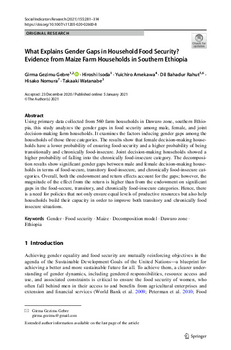What explains gender gaps in household food security? Evidence from maize farm households in southern Ethiopia
Abstract
Using primary data collected from 560 farm households in Dawuro zone, southern Ethiopia, this study analyzes the gender gaps in food security among male, female, and joint decision-making farm households. It examines the factors inducing gender gaps among the households of those three categories. The results show that female decision-making households have a lower probability of ensuring food-security and a higher probability of being transitionally and chronically food-insecure. Joint decision-making households showed a higher probability of falling into the chronically food-insecure category. The decomposition results show significant gender gaps between male and female decision-making households in terms of food-secure, transitory food-insecure, and chronically food-insecure categories. Overall, both the endowment and return effects account for the gaps; however, the magnitude of the effect from the return is higher than from the endowment on significant gaps in the food-secure, transitory, and chronically food-insecure categories. Hence, there is a need for policies that not only ensure equal levels of productive resources but also help households build their capacity in order to improve both transitory and chronically food insecure situations.

